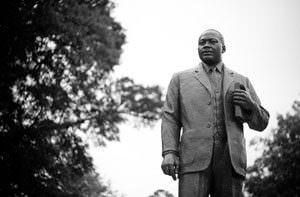Jabari Asim: Closing the Racial Gap in Medical Treatment
Why do African Americans still lag behind even recent African immigrants when it comes to beating heart disease and cancer?WASHINGTON — Recent news reports of health disparities between native-born blacks and foreign-born blacks living in the United States caught my attention, but didn’t surprise me. Like many other African Americans, I’ve long known that we tend to lag behind whites and other ethnic groups where health issues are concerned. So when I read that studies suggest black immigrants initially have lower rates of heart disease and cancer than we do, I greeted the information with a weary sigh.
At least the news gave me a chance to talk with LaSalle Leffall Jr., one of the world’s leading cancer specialists. In his memoir, “No Boundaries,” he recalled coming of age professionally during the mid-1960s, when American physicians “were just beginning to focus on statistics showing that a disproportionate number of African Americans were dying of cancer.”
In 1973, Leffall was co-author of a landmark study documenting blacks’ disproportionate cancer death rates, especially from prostate, lung and colorectal cancers. Five years later, he became the first black president of the American Cancer Society. While leading that organization, he convened the National Conference on Meeting the Challenge of Cancer Among Black Americans, the first such gathering of its kind.
I met him at his office at the Howard University medical complex. A former chair of the university’s department of surgery for 25 years, he is now its Charles R. Drew professor of surgery. I asked him about the disparity he has been wrestling with his entire career.
“The gap is still there,” he said. “Do problems remain? Yes. For example, when you talk about the five-year survival rate for any cancer, African-Americans will lag 10% to 12% behind. Even though the survival rate has increased, we’re still behind the white population.”
Leffall and his colleagues attribute the imbalance to a number of factors, including lack of access to quality care, and the prevalence of more aggressive forms of disease. “For example,” he said, “breast cancer is one of the few common cancers that is more common in white women than black women. But in young women under the age of 35 to 40, breast cancer is more common in black women and it tends to be more aggressive. That’s why all the genetic and molecular studies are being done now. You hear about genetic markers and molecular markers and tumor signaling. All of these things are so important because they will help us determine why that tumor is more aggressive in the African American.”
Lack of available, accessible and affordable healthcare, along with basic human nature, sometimes results in patients who don’t come in to see Leffall until their cancer is quite advanced. “There are only two symptoms that make patients go to doctors,” he observed. “Pain and blood. Pain because it hurts and blood because it frightens them.” To counter such reluctance, Leffall says doctors continue to stress the importance of preventive procedures such as Pap smears, mammograms and colonoscopies.
He also emphasized the need to maintain a positive mental attitude. Doing so won’t necessarily improve survival rates, but it does improve the quality of patients’ lives. “That’s so important,” he said, “because if it’s one thing we know, it’s not just that you live but how you live.”
By any measure, Leffall, 76, has led an exemplary life. In addition to his pioneering role with the American Cancer Society, he was also the first black president of the American College of Surgeons. Since 2002 he has chaired the President’s Cancer Panel, a three-member group that monitors national cancer programs and reports directly to the president. Those are just a few of his accomplishments. “I confess I have always been a man of ambition,” he says in his memoir.
So how does a man of ambition keep focused amid such daunting odds?
“The reason that I don’t get frustrated is because I see so many advances that have been made,” he explained. “When I came to medical school 58 years ago, nobody was cured of leukemia. Nobody in the world. Now if a child develops leukemia they have an 80% to 85% chance of being cured. … When I came to school, roughly 15% to 20% of patients who had cancer of the colon-rectum had to have a colostomy. Now it’s fewer than 5% of patients. Only a very small percentage. So when I see these kinds of advances, that’s what gives you hope. As a cancer surgeon and a cancer specialist, I have to say that I have boundless optimism tempered by good judgment.”
Not a bad prescription for the rest of us, while we continue to close the gap.
Your support matters…Independent journalism is under threat and overshadowed by heavily funded mainstream media.
You can help level the playing field. Become a member.
Your tax-deductible contribution keeps us digging beneath the headlines to give you thought-provoking, investigative reporting and analysis that unearths what's really happening- without compromise.
Give today to support our courageous, independent journalists.





You need to be a supporter to comment.
There are currently no responses to this article.
Be the first to respond.